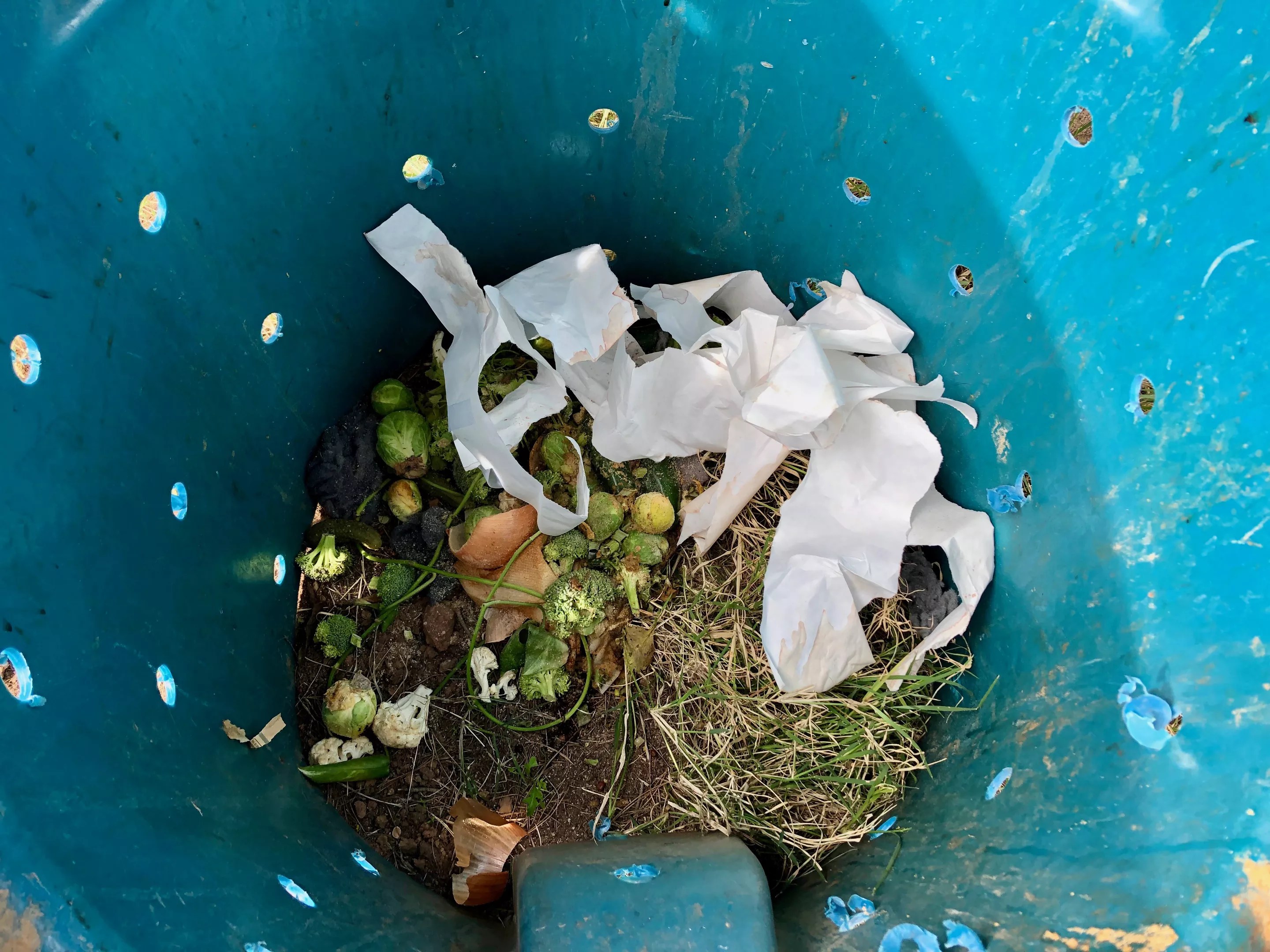
Lauren Cusimano

Audio By Carbonatix
Welcome to Table Scraps, an intermittent series on the growing problem of food waste and what some eateries, officials, farms, institutes, and everyday people are doing right. This isn’t a guilt trip, just a way to unpack initiatives attempting to reduce kitchen waste and food loss, as more than 40 percent of all food is wasted in the U.S. We’ll explore backyard composting to city programs, restaurant tips to technology, and anything related to this global issue. Heat up those leftovers and settle in.
Most of us know there is a food waste problem – a major food waste problem. But minds may wander to this being a restaurant or farm issue, or not really understanding what the actual issue may be. Many might ask, “But what can I really do?” One answer may be home composting.
But why is food waste a problem and, more importantly, why should we care?
“Food scraps and yard waste together currently make up about 30 percent of what we throw away, and should be composted instead,” according to the Environmental Protection Agency. “Making compost keeps these materials out of landfills where they take up space and release methane, a potent greenhouse gas.”
This year, make your gift count –
Invest in local news that matters.
Our work is funded by readers like you who make voluntary gifts because they value our work and want to see it continue. Make a contribution today to help us reach our $30,000 goal!
For me, that’s the scary part. The environmental harm. A Forbes article puts it nicely – well, more frighteningly: Potent greenhouse gas from food rot has “21 times the global warming potential of carbon dioxide.”
That’s not to mention carbon pollution from transporting food on those big trucks.
There are tips for better grocery shopping, storing food wisely, and so on (which we’ll get into in another installment), but developing a composting habit could divert excess food or kitchen waste from the landfill – reducing those methane emissions.
To put it in perspective, the James Beard Foundation states, “A head of lettuce takes 25 years to decompose in a landfill, but only three to six months in a compost pile.” So, yeah.
Composting is not just something done only by hardcore gardeners or people in, say, the Pacific Northwest. People do it here, too. In fact, it’s part of the Reimagine Phoenix initiative – a Phoenix Public Works program designed to increase the city’s waste diversion rate to 40 percent by 2020, and eventually to zero by 2050. It’s all spelled out in this video about the Reimagine Phoenix program.
According to city of Phoenix public information officer Matt Hamada, results from the city’s 2017-2018 waste study show food waste made up about 13.9 percent of what was in the landfill stream based on residential tonnage (tons of waste from resident garbage containers). And if you add contamination in recycling containers, total food waste in the waste stream rises to approximately 17 percent.
Recycling?
Hamada clarifies this means someone threw their leftover burger in the recycling bin, counting it as food waste, not the unscrappable peanut butter left in a jar that was recycled.
If this is all alarming to you, there are ways you can give them a hand. That means composting.
But first, you have to know how do it.
Back to the EPA. A quick visit to their website might lead you to the Sustainable Management of Food web page. You’ll see a section about what individuals can do, with a bullet for composting.
This simple EPA web page is a great resource for what composting is and how to get started. But its most beneficial trait might just be its revelation on just how simple composting can be for you and me (read that last sentence as a song).
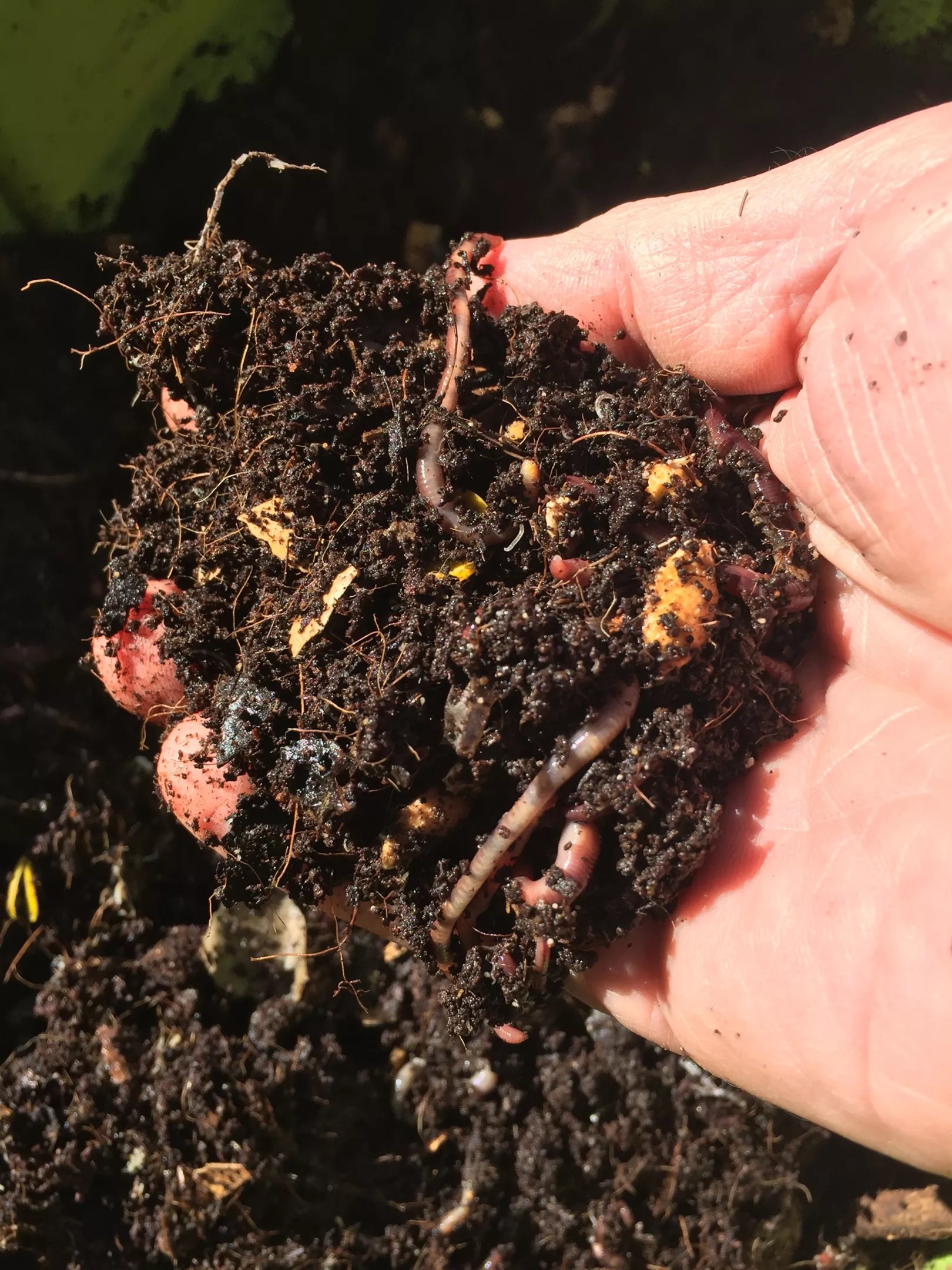
Completed compost, or “black gold.”
Courtesy of The Urban Farm
In a nutshell, compost is organic material like food scraps and yard clippings used to help plants grow by adding it to soil. And it includes nut shells.
So compost can enrich soil, reduce the need for chemical fertilizers, and reduce a landfill’s methane emissions. What’s more, it “encourages the production of beneficial bacteria and fungi that break down organic matter to create humus, a rich nutrient-filled material.” That sounds nice, too.
Black gold, as some farmers cutely call compost, is composed of three elements – brown, green, and water. Brown is yard stuff like dead leaves from that morning of raking, plus branches and twigs. Green is things like grass clippings, but also fruit and vegetable scraps and coffee grounds. Water is water.
All this goes into a pile – hence the term compost pile or heap. It’s recommended you have equal amount of browns and greens, and alternate the layers. According to the EPA, the brown materials provide carbon, the green materials provide nitrogen, and the water provides moisture to help break it all down.
One of the more fascinating aspects of this what can actually go in that compost pile.
This list is surprising, and probably longer than you think. Obvious ones include fruits and vegetables, yard trimmings, leaves, and grass clippings, and maybe hay, straw, wood chips, and sawdust. But you can also toss in eggshells (sorry, garbage disposal), coffee grounds and filters, whole tea bags, the aforementioned nut shells, and old houseplants that just aren’t going to make it and you both know it. You can also check that recycling can for paper, newspaper, and cardboard (then you shred). That can include paper towels, napkins, or tissues.
The more shocking ones, I feel, were cotton and wool rags, dryer and vacuum cleaner lint, fireplace ashes, and hair and fur. What? Every weekend of laundry, pullings from your hairbrush, and those old washcloths stolen from hotels can all be fodder for your compost pile.
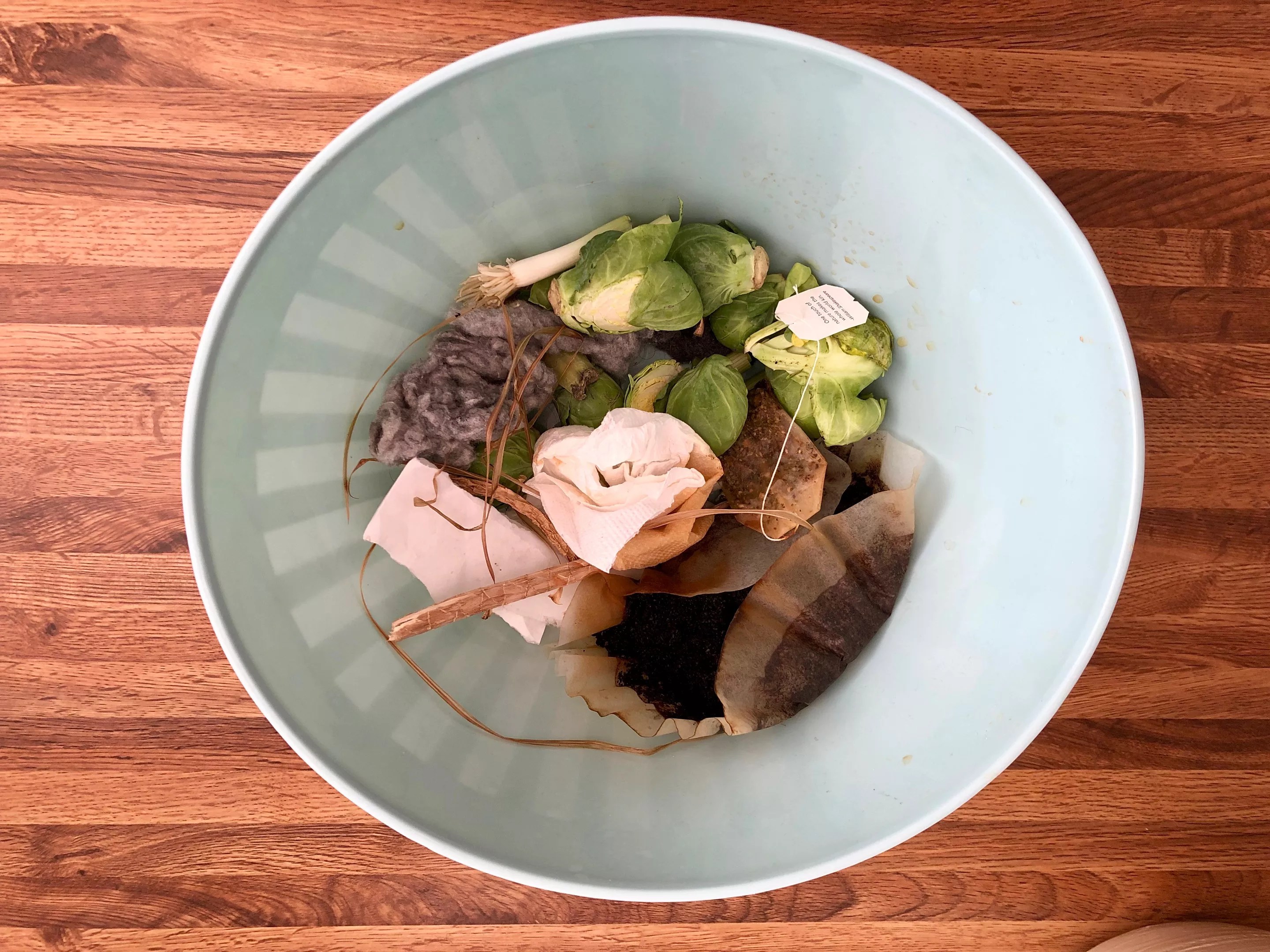
All of this can go in your compost pile.
Lauren Cusimano
The list of what not to compost is also interesting reading. No meat or dairy products, diseased or insect-ridden plants, fats, grease, lard, or oils, or yard trimmings that may contain chemical pesticides. No pet waste, either, and for the love of God, no black walnut tree leaves or twigs.
Looks like you’re ready to pile.
You might want to get yourself some gloves, a shovel, a hose and spray nozzle, and maybe a machete (how long have you been looking for an excuse to get one of those?). And this being Phoenix, maybe a hat, sunglasses, and sunscreen.
Find a dry, shady area within reach of your hose. Combine the brown and green materials, and wet down any dry material and shredded paper pieces. Make sure the fruit and vegetable scraps are buried under at least 10 inches of compost material. You can also cover with a tarp to keep things moist – a good tip for us desert composters.
Finally, according to the EPA, “when the material at the bottom is dark and rich in color, your compost is ready to use. This usually takes anywhere between two months to two years.” We better get started.
For the apartment dweller or indoor person, you can compost materials inside using the same steps as above, only placing them in a special type of bin. Your compost should be ready in two to five weeks and be fit for those indoor plants. They also assure that a properly managed compost bin will not attract pests and won’t create a funky smell. That part is up to you.
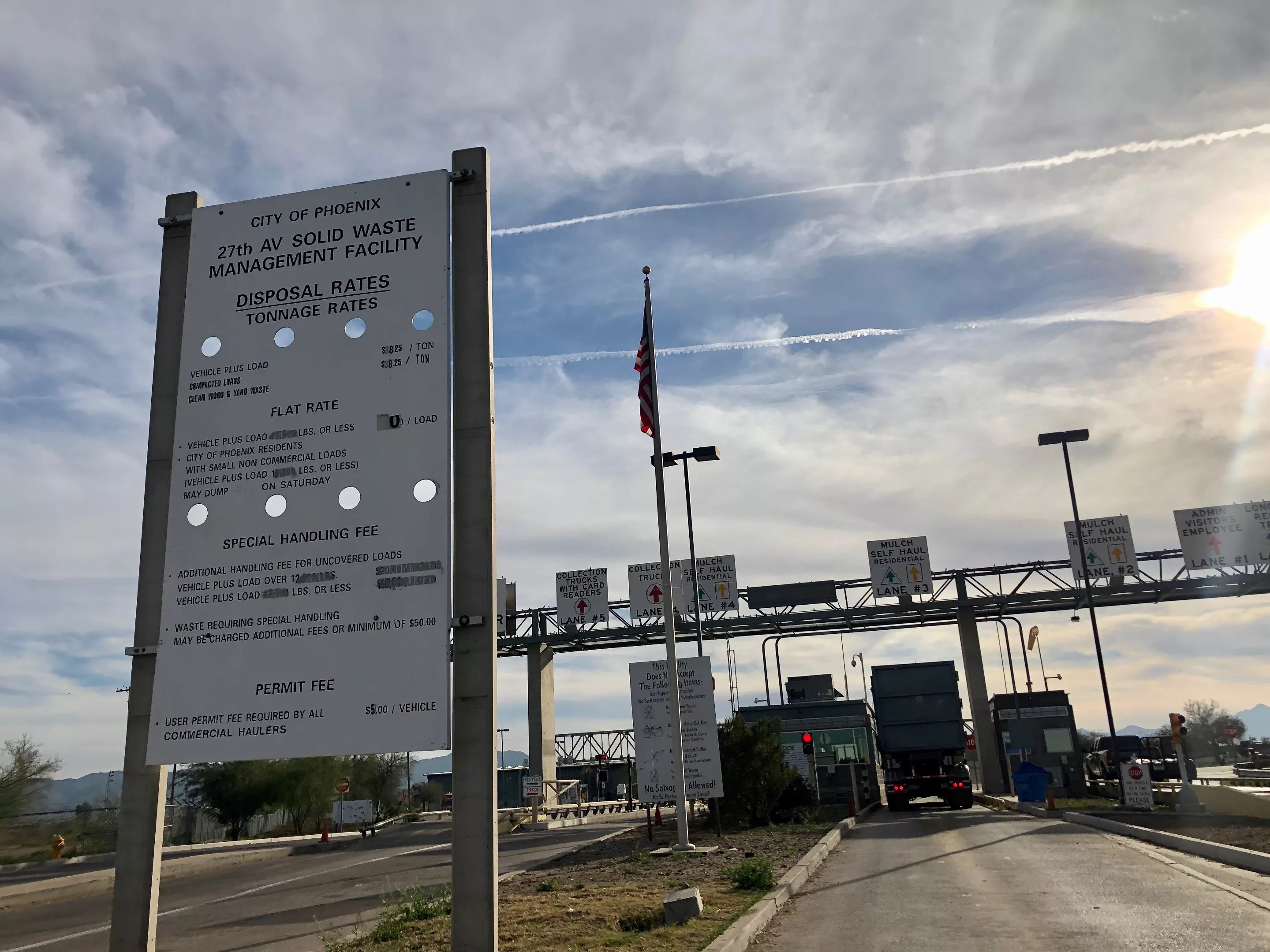
Entrance to the 27th Avenue Transfer Station.
Lauren Cusimano
Back to the bin.
You could also use a compost bin for your backyard pile. They’re found at local hardware or gardening stores, or you can make one yourself. But you could also pick one up from the city.
Phoenix compost containers are constructed by inmate work crews from old garbage and recycle cans, and are available for purchase for $5 flat – cash or card. You can pick one up at one of two transfer stations – the North Gateway Transfer Station or the 27th Avenue Transfer Station. It’s advised you call ahead for availability as containers are on a first-come, first-served basis. And no, they will not reserve a container for you.
James Massingill is a foreman for the composting diversion area at the 27th Avenue Transfer Station. He says people drop by quite a bit for the recycled compost bins. He says the bins have been available during the entirety of his eight years at the facility, and traffic has picked up recently. “Composting is starting to catch on,” he says, citing the reason may be that people are becoming more aware of food waste issues, and wanted to do something for themselves.
“I think as far as solid waste goes, Phoenix is on the leading edge,” he says. The 27th Avenue station will take old Christmas trees and landscaping trimming in order to remove the green ingredients for composting. “It’s great to keep things out of the landfills,” he says, going on to recite the goals of the Reimagine Phoenix initiative and the Phoenix compost study that involves the Phoenix Parks and Recreation Department and Arizona State University.
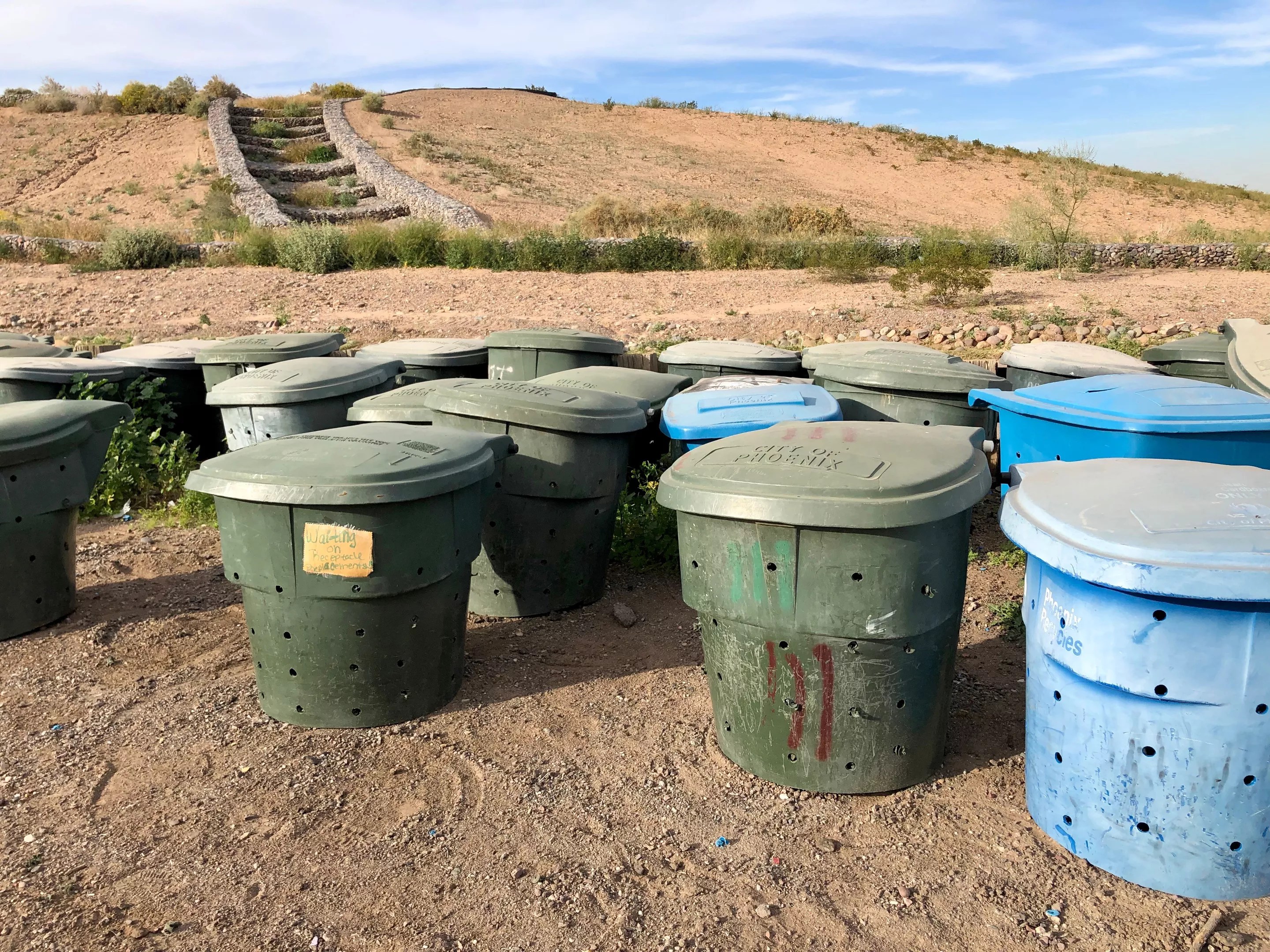
The compost bins available at the 27th Avenue Transfer Station.
Lauren Cusimano
If you happen to pick up your compost bin from the 27th Avenue station, you’ll actually be at the city of Phoenix 27th Avenue Compost Facility. This facility was unveiled in April 2017 by then-mayor Greg Stanton and the Phoenix City Council. And according to the city, “it is the first solid waste infrastructure project in the United States, and the first project in Arizona, to earn Envision recognition from the Institute for Sustainable Infrastructure.”
The facility occupies 27 acres of the Resource Innovation Campus. It also houses a Turned Aerated Pile composting system, meaning the facility has the capacity to process tons (literally) of compost in about half the time. Seriously, like 55,000 tons of inbound organics per year. This technology supports the making of a stable compost in about 60 days, which is faster than other composting methods. There’s also potential to up the ante. According to Public Works, the facility was designed to be scalable up to 220,000 tons capacity per year with additional construction if the market and inbound feedstock levels can support it.
And aside from that just being a cool fact, there’s a reason we’re telling you this. If you dig the idea of composting, but just don’t have the time or energy or you actually just go out to eat a lot, the 27th Avenue Compost Facility does sell compost to Valley residents through a contractor WeCare Denali.
The contractor is a seal of testing assurance certified compost participant and merger result of WeCare Organics and Denali Water Solutions. WeCare Denali is contracted by the city to operate and maintain the city-owned facility. The company produces its certified compost at the 27th Avenue facility, and markets the product throughout the community. The city also conducts periodic compost giveaway events for Phoenix residents.
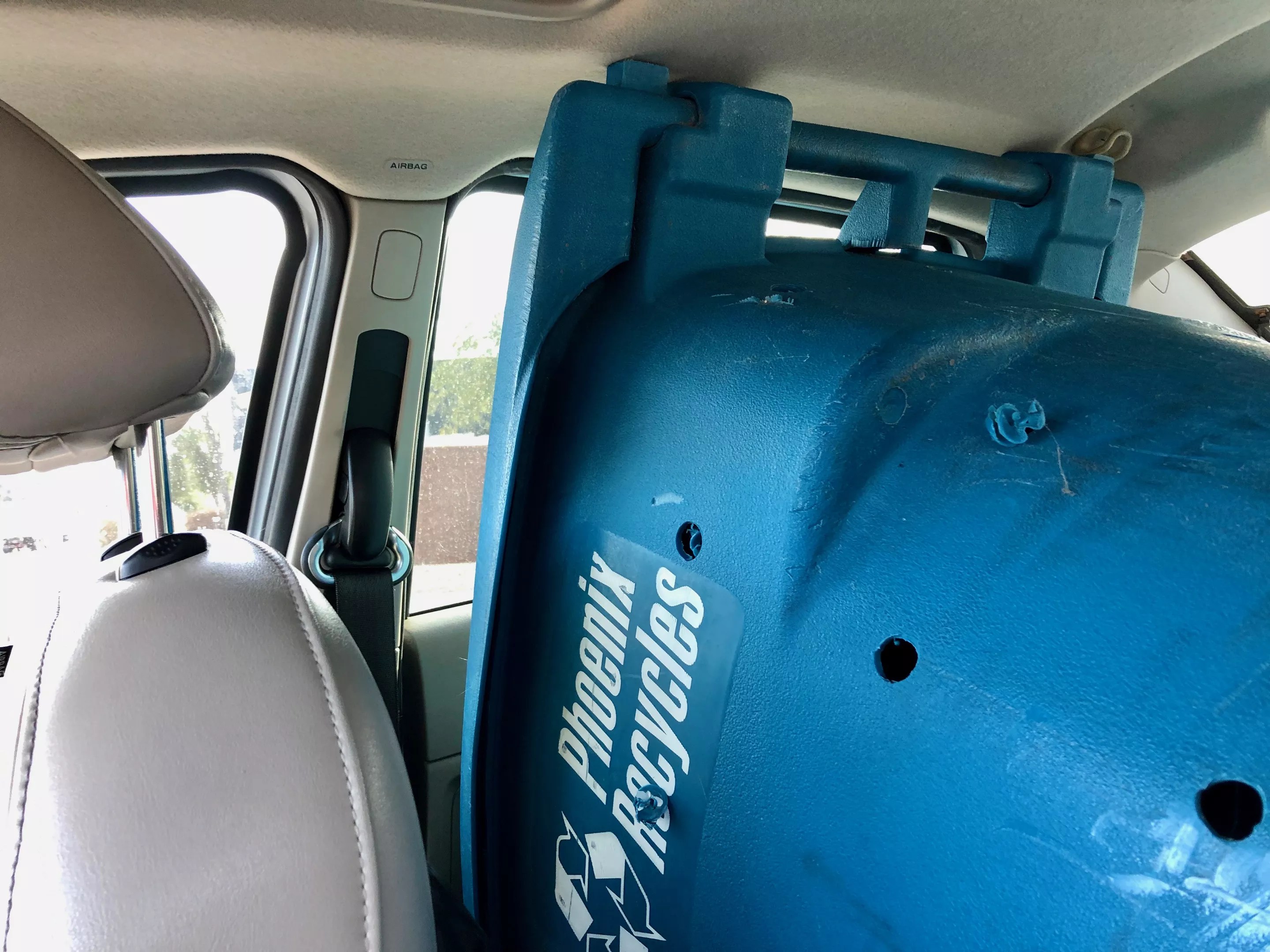
Yes, they can fit in a small sedan…sort of.
Lauren Cusimano
What’s more, the facility recently hosted the compost facility tour as one of the highlights of Compost 2019 – the U.S. Composting Council‘s conference and trade show that was held at the Renaissance Glendale Hotel & Spa in Glendale the week of January 28. Phoenix was the host city for the 27th annual conference for the first time this year.
That was good news to Massingill. “Everyone should visit here at least once,” he says with a smile as he jams my “new” compost bin into the back of my compact sedan. Thank God the door was able to shut, but the real challenge came later in getting the bin out of the car.
Now, we’d like to think this article was informative and gripping, giving you everything you need to know to start composting within the hour. But of course, nothing is as easy as you read that it is. Good thing there are places throughout the Valley that can help. The Urban Farm, Arizona Worm Farm, ASU Chandler Innovation Center, Desert Botanical Garden, the University of Arizona Maricopa County Cooperative Extension, and more places have all held classes on composting.
Happy piling.